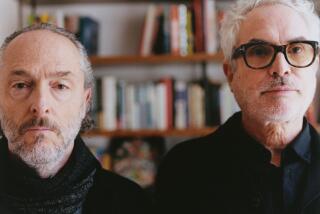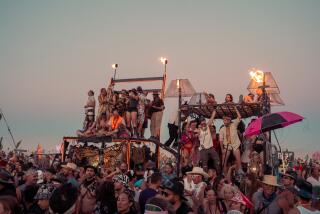âThe Revenantâ cinematographer Emmanuel Lubezki shares Instagram pics and memories from making the film
Even those who didnât embrace âThe Revenant,â Alejandro G. Iùårrituâs brutal frontier story of survival, surely will concede that the movieâs images are stunning â and, as captured by Oscar-nominated cinematographer Emmanuel Lubezki and his crew, are a must to experience on the big screen. But if the more than 200,000 people who follow Lubezki on Instagram are any indication, his images can be just as powerful on a smartphone. Below are the raw images.
Lubezki, who after consecutive Oscar wins for âGravityâ and âBirdmanâ could be the first cinematographer to take home the prize three years in a row, uses the photo-sharing site as a visual on-set diary, catching moments between filming that enrich and expand his moviesâ already heady visuals. Looking at these stills created while shooting âThe Revenantâ in Canada and Argentina (and, for the most part, titled here as he has them on Instagram), Lubezki reflects in an interview with The Envelope on the rigors of the notoriously difficult shoot, the ephemerality of natureâs beauty, and why the best moments are often the ones when the cameras arenât rolling.
âItâs the Elbow River in Alberta, a couple years before we shot there. It created a lot of chaos and a lot of roads were destroyed. In this photo, it looks simple and beautiful. As youâre scouting [the location] and you see the roads that are destroyed, you know youâre getting into trouble. You cannot tame nature. Nature is much more powerful than anything. So we knew that we were going to get into trouble at one point or another as we were shooting the movie.â
âIt was already winter. The days were close to 0, -4, -5 [Celsius]. We said, âOh, weâre going to triumph. This winter is incredible because itâs snowing, it looks beautiful, and itâs very manageable.â And the next day, boom, the weather changed, and it dipped into -27, even during the day. It became very hard to work. It was the first shock. It really brought fear to us because at that point, we didnât know what to expect anymore. The river that surrounded our location started freezing into chunks of ice, and the river started to go off its course and started flooding our location. It was one of the main locations, where [the characters in the film] Fitzgerald and Bridger abandon Glass. It was a little peninsula surrounded by water, and it started to disappear. We had to evacuate the crew. And then we had a couple days where the weather got even worse.â
âEvery time we start a movie with Alejandro, we have a little ritual that he invented. Itâs very beautiful and very moving. Itâs not religious. It is spiritual. And it really helps everybody to know how passionate he is about the movie and it gets people close together. On top of that, we were working in native lands, and we had a couple of Native American people in the crew, who were not only acting in the movie but trying to keep us honest. Part of the day was to meet each other, and Craig Falcon, the gentleman that is doing the blessing, had invited some elder people and was blessing the movie and blessing the set and thanking the gods for allowing us to be there and protecting us.â
âWhen you work with very good people, you can see the transformation of the extras and all the people into characters â the makeup, the hair and, in this case, the incredible costumes. But there was something else this time. I felt that the people coming were much more than extras. They were people that knew the land, and people that had a lot of respect for this story. Itâs hard to tell you, and thatâs why I sometimes donât like to talk about it; itâs something you can see in the photos but you cannot explain with words. This photo, itâs a man that came from the north of Argentina to work in the movie, and weâre shooting in the south of Argentina, in Ushuaia, so itâs thousands of miles away, and I just thought he had a very powerful face.â
âI had seen photos of a frozen lake farther north in Alberta. What happens there is that the water freezes, and big bubbles of methane get stuck. It almost looks like glass, and you can see these massive bubbles underneath. But just a few days later, after the scout, it snowed again, so you could not see the glassy surface anymore. It was all white. Thatâs what happens when you shoot in nature. You have to be very flexible and fast. Many times, the most beautiful things and the most magical things happen when youâre not shooting. What I love is just the patches of light and how fast the clouds were moving. You can see a patch of hard light on the surface of the lake. You can see the hard light of the sun. That patch of light was moving really, really fast, and it was just really spectacular. I love the depth of the picture. You can see thousands of meters away. You have to deal with the unpredictability of the weather and of nature, but if you move fast, you can capture these fleeting moments. When you are able to show that to people, you express something that is hard to express on film, that is the ephemeral -- how ephemeral are these magic little moments, and how ephemeral is our life.â
â[Production designer] Jack Fisk made this small dwelling out of wood and we had some propane inside. That afternoon, we started playing with the actors and suddenly I said, âWhy donât we use fire?â So we started playing with fire, me telling them to burn the walls of the dwelling. We asked for a little more, and suddenly the dwelling caught on fire. And the moment that the fire was real, and not organized by the effects people, it started to be more magical and more interesting. Then we got a gust of wind and we couldnât control the fire anymore. The special effects guy said if we donât shut it down, itâs going to burn the dwelling, we wonât be able to use it again. It doesnât matter. Let it burn.â
âWe saw this forest many times while we were driving from one location to another. Itâs a very special forest because itâs sick, one that has been attacked by some insects. Itâs a very weird color. The trunks look almost lead-ish, metallic, and there is no growth underneath, and they have almost no leaves. So itâs very graphic. You have a lot of depth. You can see 1 kilometer deep. We didnât want to use artificial light at all. [But] there was a big bright light that we had put there just for the crew and horsemen to be able to know where we were for between the takes. So this happened before we turned that artificial light off. Itâs beautiful because itâs a single source, which you are not sure what it is, if itâs an artificial light or the sun or the moon, and you can see the shadows of the trunks toward the lens and the little silhouettes of the horses.â
âThat was incredible. Iâd never seen an aurora borealis before. We were almost at the end of the shoot, running out of snow, so we had to go up to this place called Fortress Mountain â 8,000 feet, almost to the top of the highest mountain in that area. The actors left, and while we were picking up the gear, we suddenly started seeing the aurora borealis. It was pretty spectacular. I ran to the camera Ski-Doo, and I realized the camera was already going down the mountain. Suddenly, we started seeing the green reflection of the aurora borealis in these massive walls that are thousands of feet tall. It looked incredibly mysterious. You cannot even think about it if you are doing a movie in the studio, that you are going to shoot the reflection of the aurora borealis in the wall of a mountain. Itâs an incredible miracle that happened right in front of us.â
âWe were waiting for Leo [DiCaprio] and his team to come to the set to rehearse, and suddenly these incredible clouds, this incredible light happened right in front of us. Again, itâs those moments that you are not really shooting. You are just waiting to make the movie.â
âThis is one of the extras in the fort in Canada. His beard looks unkempt, and he looks period. Again, I donât know how to explain it, but when these people arrive to the set, sometimes it felt like they had been there for hundreds of years waiting for this to happen. Itâs incredibly difficult to find faces like this. People now look like theyâre watching TV and the Internet. I think Alejandro and his team did an amazing job, and obviously the makeup and wardrobe helps a lot. But when you find a person like this, you are very lucky.â
âWe were looking for a burnt forest. There are big areas in that part of Canada that were burnt by a big fire that happened just a couple years ago, but they are very hard to access, so we had to rent a helicopter to fly around and get to this place. What I love is all these different textures that you can see: the flat ice, the frozen lake in the distance, and in the foreground you have all these trees. We scouted, it was a very hard walk, because the snow was very high. It took hours to recon the place. A couple weeks later, we decided it was too hard to get the crew there, and we shot the scene somewhere else that wasnât as beautiful as this.â
More to Read
The biggest entertainment stories
Get our big stories about Hollywood, film, television, music, arts, culture and more right in your inbox as soon as they publish.
You may occasionally receive promotional content from the Los Angeles Times.










